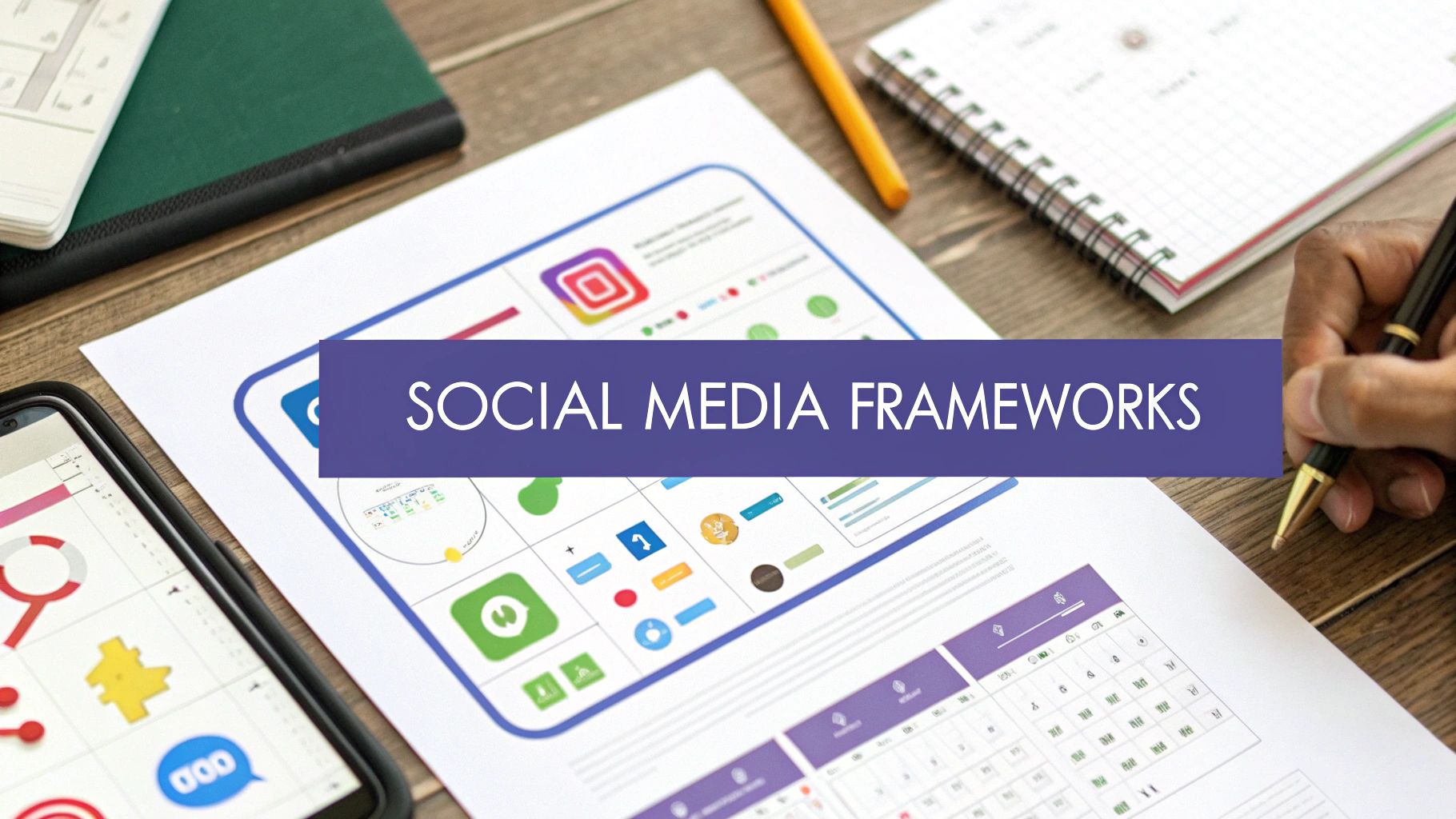In the ever-evolving world of social media, simply 'being present' is no longer enough. To truly succeed, social media managers must evolve from content publishers to strategic community builders, data analysts, and trend forecasters. The pressure is immense, but the right strategies and tools can transform chaos into a high-performing, streamlined operation.
This guide moves past generic advice, offering potent, actionable social media manager tips designed to elevate your management game. We will explore advanced techniques that deliver tangible results, from deep audience analysis and creating a consistent content calendar to mastering platform-specific nuances. Each tip is crafted to be immediately implementable, helping you refine your approach and prove your return on investment with confidence.
Throughout this listicle, we'll demonstrate how integrating a powerful tool like PostSyncer can turn these expert strategies into a seamless, automated reality. You'll learn not just what to do, but how to do it efficiently. Get ready to move beyond the basics, drive meaningful engagement, and build a social media presence that makes a measurable impact on your brand's bottom line.
1. Tip 1: Know Your Audience Beyond Demographics
The foundation of any successful social media strategy is a profound understanding of your audience. While basic demographics like age, gender, and location provide a starting point, top-tier social media managers know that this data only scratches the surface. To create truly impactful content, you must move into the realm of psychographics, uncovering the values, interests, pain points, and motivations that drive your followers' behavior.
This deeper dive transforms your content from a generic broadcast into a meaningful conversation. Instead of just knowing who your audience is, you learn why they do what they do. Why do they follow you? What problems are they actively trying to solve? What kind of content makes them stop scrolling? Answering these questions is one of the most vital social media manager tips for fostering genuine connection and loyalty.
How to Uncover Psychographic Insights
Building these detailed audience personas requires a multi-faceted approach. Don't just rely on platform analytics; actively seek out qualitative data.
- Social Listening: Monitor conversations happening in your comment sections, DMs, and relevant online forums or groups. What language do your followers use? What are their biggest frustrations or aspirations?
- Audience Surveys: Use tools like Google Forms or Instagram Stories' poll feature to directly ask your audience about their preferences, challenges, and content consumption habits.
- Competitor Analysis: Analyze the comment sections of your direct competitors. What are their followers asking for? What content generates the most emotional response?
By understanding your audience's core motivations, you can craft a content strategy that speaks directly to their needs, turning passive viewers into an engaged community. This foundational knowledge informs everything from your brand voice and content pillars to the platforms you prioritize, making it an indispensable first step.
2. Create a Consistent Content Calendar
Consistency is the currency of social media, and a content calendar is the tool that mints it. A well-structured calendar is far more than a simple schedule; it's a strategic roadmap that ensures a steady, reliable presence across all your platforms. It allows you to organize themes, align posts with business goals, and maintain a cohesive brand voice, transforming your social media efforts from reactive to proactive.

This strategic foresight prevents the last-minute scramble for content and ensures you're never sacrificing quality for the sake of posting. By planning ahead, you can dedicate more time to community engagement, performance analysis, and creative ideation. For social media managers juggling multiple accounts or campaigns, a calendar is one of the most essential social media manager tips for staying organized, efficient, and impactful.
How to Build an Effective Content Calendar
An effective calendar balances meticulous planning with the agility needed for social media. It should be a living document, not a rigid set of rules. For instance, brands like Starbucks masterfully align their calendars with seasonal product launches, building anticipation and driving sales.
- Adopt the 70/30 Rule: Plan approximately 70% of your content in advance. This includes evergreen posts, campaign announcements, and educational series. Leave the remaining 30% open for spontaneous content, like engaging with trending topics, sharing user-generated content, or posting behind-the-scenes moments.
- Use Planning Tools: Leverage platforms like PostSyncer, Buffer, or CoSchedule to visualize your schedule, draft posts, and automate publishing. This frees up valuable time for more strategic tasks. For an in-depth guide and a ready-to-use template, you can learn more about how to create a consistent content calendar.
- Color-Code for Clarity: Assign different colors to content pillars (e.g., educational, promotional, community), platforms, or post formats (e.g., video, carousel, static image). This provides an at-a-glance overview of your content diversity and distribution.
By implementing a content calendar, you establish a reliable rhythm that your audience can count on. This consistency not only satisfies platform algorithms but also builds trust and anticipation within your community, turning casual followers into loyal fans who look forward to your next post.
3. Master Platform-Specific Best Practices
A fatal error for many brands is adopting a "one-size-fits-all" approach to social media. Posting the exact same content across every platform ignores the unique culture, algorithm, and user expectations of each network. A top-tier social media manager understands that a viral TikTok video won't necessarily perform as a LinkedIn post, and an image that thrives on Instagram may fall flat on X (formerly Twitter). To maximize reach and engagement, you must tailor your content, tone, and strategy to each platform's specific environment.
This platform-centric method means creating content that feels native to where it's being consumed. It’s about leveraging the unique features and user behaviors of each network, from Chipotle's masterful use of trending audio on TikTok to HubSpot’s authoritative, long-form thought leadership on LinkedIn. This is one of the most crucial social media manager tips because it demonstrates a sophisticated understanding of the digital landscape, allowing you to connect with users in the way they prefer to be engaged on that specific app.

How to Implement a Platform-Specific Strategy
Developing a nuanced, multi-platform strategy requires deliberate effort and ongoing education. Instead of simply cross-posting, you should actively adapt your core message for each channel.
- Study Platform Updates: Algorithms are constantly changing. Follow official blogs from platforms like Meta, TikTok, and LinkedIn, and pay attention to creator communities to stay ahead of shifts in what content gets prioritized.
- Use Native Features: Prioritize using in-app tools for editing videos (like Instagram Reels or TikTok editor) and new features like polls or Q&As as they launch. Platforms often reward creators who adopt new functionalities early.
- Create Platform Templates: Develop distinct content templates and brand guidelines for each network. For example, your Instagram template might focus on high-resolution visuals, while your X template prioritizes concise, impactful text.
- Analyze Platform-Specific Data: Don't lump all your analytics together. Track the best times to post, top-performing formats, and audience engagement metrics separately for each platform to refine your approach.
By respecting the individuality of each platform, you stop being an intruder in your audience's feed and start becoming a welcome, native part of their online experience. This builds credibility and significantly boosts your content's performance.
4. Engage Authentically and Promptly
Social media is a two-way street, not a broadcast channel. The most successful brands understand that its primary function is building relationships and fostering community. Authentic engagement means moving beyond automated replies and scheduled posts to interact with your audience in a genuine, helpful, and timely manner. It involves actively listening, showing real interest in your followers' opinions, and building true connections.
This approach transforms your social media presence from a simple marketing tool into a vibrant community hub. By responding to comments, messages, and mentions with a human touch, you demonstrate that your brand values its audience. This is one of the most effective social media manager tips for building trust and turning followers into loyal advocates, as demonstrated by brands like Wendy's with its witty Twitter presence and Zappos with its legendary customer service.

How to Foster Authentic Engagement
Creating a system for prompt and genuine interaction requires structure and clear guidelines. Your goal is to be both efficient and personal, ensuring no follower feels ignored.
- Set Up Social Monitoring: Use tools to track brand mentions, relevant keywords, and industry conversations across all platforms. This allows you to proactively join discussions and respond to feedback you might otherwise miss.
- Establish Response Time Goals: Speed is crucial in social media. Aim to respond to all inquiries within a few hours during business hours. Acknowledging a comment or question quickly shows your audience that you are present and attentive.
- Personalize Your Responses: Create templates for common questions to ensure efficiency, but always empower your team to personalize them. Using the person's name and referencing their specific comment makes the interaction feel unique and valued.
- Define Your Brand Voice: Train your team on the brand’s specific voice and tone for engagement. Is your brand witty, empathetic, professional, or playful? Consistency in your communication style builds a recognizable and relatable brand personality.
By prioritizing authentic and prompt engagement, you invest in the long-term health of your community. These meaningful interactions are the bedrock of brand loyalty and can significantly boost your online reputation. To explore this topic further, you can discover strategies for how to improve social media engagement on postsyncer.com.
5. Leverage Data Analytics for Continuous Improvement
In social media, intuition and creativity will only get you so far. The most effective strategies are built on a foundation of data, transforming guesswork into a predictable science. Data-driven decision-making involves regularly analyzing performance metrics, audience insights, engagement patterns, and conversion data to understand what truly resonates with your audience and drives business objectives.
This analytical approach is what separates good social media managers from great ones. It allows you to move beyond vanity metrics like likes and followers to measure what really matters: website traffic, leads, and sales. By grounding your strategy in concrete evidence, you can justify your efforts, optimize your budget, and consistently refine your approach. This is one of the most critical social media manager tips for proving ROI and achieving sustainable growth.
How to Implement a Data-Driven Strategy
Turning raw data into actionable insights requires a systematic process. Integrate these practices into your regular workflow to ensure you're always optimizing for success.
- Establish Key Performance Indicators (KPIs): Before you can measure success, you must define it. Set clear, measurable KPIs that align with your business goals, such as click-through rate (CTR), conversion rate, or cost per lead.
- Create Regular Performance Reports: Develop a habit of creating monthly or quarterly reports that track your KPIs. This not only keeps stakeholders informed but also helps you spot trends, identify top-performing content, and pinpoint areas for improvement. You can even use our social media analytics report template to get started quickly.
- Utilize UTM Tracking: Use UTM parameters on all your social media links to accurately track how much traffic and how many conversions each platform, campaign, and post generates in Google Analytics. This gives you a clear view of your social media ROI.
Beyond basic reporting, truly effective social media managers leverage sophisticated insights. This includes a deep understanding of video performance; for instance, mastering video marketing analytics can reveal which video formats hold attention longest and drive the most engagement. By consistently analyzing your data, you can stop making assumptions and start making informed decisions that amplify your results.
6. Stay Current with Trends and Platform Updates
The social media landscape is in a constant state of flux, with algorithm tweaks, new feature rollouts, and shifting user behaviors happening almost daily. Elite social media managers recognize that what worked yesterday might be obsolete tomorrow. To maintain a competitive edge, you must embrace a mindset of continuous learning, staying ahead of industry news, emerging trends, and platform updates.
This proactive approach is what separates reactive management from strategic leadership. Instead of scrambling to catch up, you position your brand to capitalize on new opportunities early, like Duolingo did by mastering TikTok's meme culture or how savvy B2B brands leveraged LinkedIn's newsletter feature for thought leadership right after its launch. This agility is one of the most crucial social media manager tips for ensuring long-term relevance and growth.
How to Stay Ahead of the Curve
Staying informed requires building a system for gathering and acting on intelligence. This isn't about jumping on every fleeting meme; it's about making strategic decisions based on where the platforms and audiences are headed.
- Follow the Source: Subscribe to the official blogs and creator update channels for each major platform you use (e.g., the Instagram @creators account, Meta for Business blog). These are your primary sources for official news on features and algorithm changes.
- Join Industry Communities: Engage with online communities and forums for social media professionals on platforms like LinkedIn or Reddit. Following analysts like Matt Navarra or publications such as Social Media Today provides curated, expert insights.
- Allocate Time for Experimentation: Dedicate 10-15% of your content calendar to testing new formats and features as soon as they become available. This allows you to learn what works for your audience in a low-risk environment before committing significant resources.
By integrating these habits into your workflow, you transform from a content publisher into a forward-thinking strategist. You'll be equipped to pivot quickly, innovate consistently, and deliver results that keep your brand at the forefront of the conversation.
7. Develop a Strong Brand Voice and Visual Identity
In a crowded digital landscape, consistency is currency. A strong, recognizable brand voice and visual identity are what transform a generic social media presence into a memorable brand experience. This goes beyond just using the same logo; it’s about creating a cohesive personality that your audience can connect with emotionally, building trust and recognition with every post.
This consistency ensures that whether a follower encounters your brand on Instagram, TikTok, or LinkedIn, the experience feels familiar and authentic. Think of Innocent Drinks' playful, conversational tone or Apple's clean, minimalist aesthetic. This is one of the most powerful social media manager tips because it establishes a predictable yet engaging framework that makes your brand instantly identifiable and helps it stand out from the noise.
How to Build a Cohesive Brand Identity
Defining your brand's personality requires deliberate planning and documentation. Your goal is to create a guide that anyone on your team can use to produce on-brand content.
- Create a Brand Voice Document: Go beyond "friendly" or "professional." Define your brand's personality traits (e.g., witty, authoritative, nurturing). Document your communication style, including specific words to use or avoid, grammar rules (like using the Oxford comma), and how to handle emojis.
- Develop Visual Templates: Use tools like Canva or Figma to create a set of approved templates for different types of content (e.g., quotes, announcements, stories). Standardize your color palette, typography, and logo usage to ensure visual harmony across all platforms.
- Audit for Consistency: Regularly review your published content across all channels. Does it align with your documented voice and visual guidelines? This audit helps catch inconsistencies before they dilute your brand identity.
By creating and enforcing these standards, you ensure every piece of content reinforces your brand's core identity. This strategic approach fosters deeper audience connection and builds the kind of brand loyalty that turns followers into true advocates.
7 Essential Social Media Manager Tips Comparison
| Strategy | Implementation Complexity 🔄 | Resource Requirements ⚡ | Expected Outcomes 📊 | Ideal Use Cases 💡 | Key Advantages ⭐ |
|---|---|---|---|---|---|
| Know Your Audience Inside and Out | High: in-depth research and ongoing updates | Moderate to High: analytics tools, surveys | Targeted engagement, improved ROI, loyalty | Foundational marketing strategy, audience targeting | Higher engagement, better ROI, loyal community |
| Create a Consistent Content Calendar | Moderate: upfront planning with ongoing review | Moderate: planning tools, team coordination | Consistent brand presence, strategic campaigns | Teams managing multi-platform content | Ensures consistency, reduces stress, improves collaboration |
| Master Platform-Specific Best Practices | High: continual adaptation per platform | High: content creation tailored per platform | Higher organic reach, competitive advantage | Multi-platform marketing, maximizing organic reach | Better algorithm performance, authentic presence |
| Engage Authentically and Promptly | High: real-time monitoring and response | High: dedicated human resources | Stronger brand trust, improved engagement | Customer service, community building | Builds loyalty, boosts engagement, creates advocates |
| Leverage Data Analytics for Continuous Improvement | Moderate to High: ongoing data collection and analysis | Moderate to High: analytics software and expertise | Data-driven optimizations, clear ROI | Performance optimization, strategy refinement | Evidence-based decisions, identifies winning content |
| Stay Current with Trends and Platform Updates | High: continuous learning and testing | Moderate: time investment in monitoring | First-mover advantage, increased reach | Fast-evolving platforms, innovation-driven brands | Early adoption, better algorithm adaptation |
| Develop a Strong Brand Voice and Visual Identity | Moderate: intensive upfront development | Moderate: design and training resources | Brand recognition, emotional connection | Brand building, long-term audience engagement | Strong differentiation, trust, easier content creation |
Your Blueprint for Strategic Social Media Management
Navigating the dynamic landscape of social media requires more than just posting content; it demands a strategic, agile, and data-informed approach. The social media manager tips we have explored throughout this guide are not isolated tactics but interconnected pillars of a comprehensive strategy. From deeply understanding your audience's motivations to developing a consistent brand voice and leveraging robust analytics, each element works in concert to build a resilient and impactful online presence.
Moving forward, the goal is to transition from a reactive manager, constantly putting out fires and chasing trends, to a proactive architect of digital experiences. This evolution is the core difference between simply maintaining social accounts and strategically driving business growth. The path to mastery involves building systems that streamline your workflow, automate repetitive tasks, and provide the clarity needed for high-level decision-making. Think of it as constructing a powerful engine for your social media efforts, allowing you to focus your creative energy where it matters most: building genuine connections and delivering value to your community.
Key Takeaways for Your Workflow
To put these concepts into practice, concentrate on these core takeaways:
- Audience-Centricity is Non-Negotiable: Every piece of content, every engagement, and every campaign must begin and end with your audience. Use analytics and social listening to move beyond demographics and understand psychographics, pain points, and desires.
- Consistency Breeds Trust: A reliable content calendar, a stable brand voice, and a consistent visual identity are the foundations of brand recognition and trust. Your audience should know what to expect from you, which keeps them coming back.
- Data is Your Compass: Do not rely on guesswork. The insights gleaned from your analytics are your most valuable resource for refining your strategy, optimizing content performance, and proving ROI. Make data review a non-negotiable part of your weekly routine.
- Adaptability is Your Superpower: The digital world is in a constant state of flux. Your ability to stay informed on platform updates, embrace new content formats, and pivot your strategy based on performance data will set you apart from the competition.
Your Actionable Next Steps
The journey to becoming a top-tier social media manager is continuous. Start by auditing your current workflow against the tips outlined in this article. Identify one or two key areas for immediate improvement. Perhaps it is formalizing your content calendar or dedicating more time to data analysis.
Embrace the power of purpose-built tools to create efficiency and unlock deeper insights. A centralized platform is no longer a luxury; it is a necessity for managing multiple accounts, scheduling platform-specific content, and tracking complex metrics without feeling overwhelmed. By implementing these social media manager tips, you are not just improving your daily tasks. You are building a sustainable framework for career growth and measurable business success. The strategies are here, the tools are available, and the opportunity to lead is yours.
Ready to transform these tips into an efficient, powerful workflow? PostSyncer provides the centralized dashboard you need to plan, schedule, optimize, and analyze your social media efforts across all platforms. Stop juggling tabs and start building your social media empire by visiting PostSyncer to see how our tools can revolutionize your strategy.















